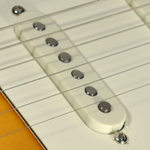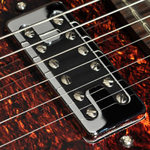Since Maury’s Music first became a Reverend Guitar dealer, one of the things I’ve enjoyed the most has been experimenting with the numerous pickup options offered. With over a dozen unique designs and countless individual configurations, there is truly something for everyone. The flipside of this though is that, if you aren't quite sure what you're looking for the the number of options can be daunting. So we're going to start at the beginning and give a basic explanation of what kinds of pickups are available on the market today and how they function.
What is a pickup and how does it work?
Before we talk too much about the differences between pickup styles, it’s best to explain exactly what a pickup is and how it works. In its most basic form an electric guitar pickup is a magnet wrapped repeatedly in a very thin copper wire. This copper wire is extremely thin and can be wrapped around the magnet thousands of times in a single pickup. When you strike a string on your guitar the flux-field created by the magnet moves in relation to how quickly the string is vibrating. The pickup as a whole acts as a transducer, converting the energy of this vibration interacting with the magnet into electrical energy. This electrical signal passes through your guitar cable and into the amplifier where it is again converted into vibrational energy, this time in the speaker cone. The cone vibration pushes air from the speaker, generating audible sound.
Single Coils and Humbuckers


On the left we have a Reverend Single Coil pickup. On the right is a Reverend Humbucker.
The earliest guitar pickups consisted of a single magnet with one coil of copper around them. Over the years other designs were devloped and gained popularity, this pickup became known commonly as a “Single Coil”. Single coils remain a popular choice among electric guitar players for their brightness and clarity. Single coil pickups also tend to cut through a mix well, making them a popular choice for playing leadwork.
Here is a video of Chris Davis, a friend of Maury's Music, demoing a Reverend Six Gun. With 3 S-Style single coil pickups, the Six Gun is a perfect example of classic Single Coil tone:
One of the biggest potential drawbacks of a Single Coil pickup is their almost trademark hum and buzz. Their single copper coil makes them prone to electromagnetic interference and can result in 60 cycle hum. This hum is almost always prevalent in varying degrees and can be made louder depending on what conditions the guitar is played in. Being around neon lights or other electronics can increase the volume and make the hum more noticeable. The use of distortion will also increase the hum. A single coil can also act as an antenna, picking up interference from the air (So much so that I’ve been in situations where I actually picked up up a radio broadcast that could be heard through my amplifier). This interference can be mitigated in a few different ways, such as properly shielding the pickup cavity in the guitar body.
The Humbucker pickup was designed to solve the interference problems associated with Single Coil pickups. First originating in the 1930s, Humbuckers gained widespread popularity in the 1950s with Seth Lovers’ invention of the P.A.F. pickup. A Humbucker is made using two copper coils and two magnets. The magnets are oriented in opposite directions and the coils are wound in separate directions, one clockwise and the other counterclockwise. When the guitar is played, the direction of the electrical signal created by the vibration of the strings move through the pickup in a direction that is dependent on the orientation of the magnet. However, the signal caused by interference will always move through the coil in the direction the coil is wrapped. Because of this, the sum of the signal from the two coils can be taken, preserving the actual string signal while removing (or “bucking”) the hum and buzz. The end result of this two coil configuration is that you end up with a cleaner signal reaching your amplifier as well as a higher output.
Here's Chris again with a Reverend Warhawk, a guitar with two Humbucker pickups:
So if Humbuckers give a cleaner and stronger signal, why do they still bother to make Single Coils? The answer comes down to desired tone. Humbuckers are generally described as having a warmer, “fatter” sound than Single Coils, mostly do to a better midrange output. The amount of distortion desired may also push players towards one pickup or another. As mentioned earlier, distortion can make 60 cycle hum louder so musicians who want a lot of distortion tend to lean more towards Humbuckers. However, this warmth comes at the cost of high end. The inherent warmth of Humbuckers means that they will never have the same chime or sparkle that a single coil pickup has.
The reason I decided to focus primarily on basic Single Coil and Humbucking pickups is simply that they are both the most common. However, in the decades since their respective inventions there have been countless variations made on these two basic designs. Rail pickups, Stacked Humbuckers and Split pickups are a few examples. In future articles as we begin to look at specific Reverend pickup designs, we’ll begin to look at some of these variations more closely.
If you're brand new to electric guitars I hope you've found this article informative. Learning a little bit about the innerworkings of their guitars is important for players of all skill levels. At the end of the day, guitars are tools and having a core understanding of how they operate makes it a whole lot easier to narrow down your choices and find the guitar with the tone you're looking for. In the future I hope to be able to highlight some of my favorite pickups made by Reverend Guitars. In the meantime we're always interested to hear what our customers prefer. Be sure to comment below to let us know what your favorite electric guitar pickups are and what kind of music you're playing with them.